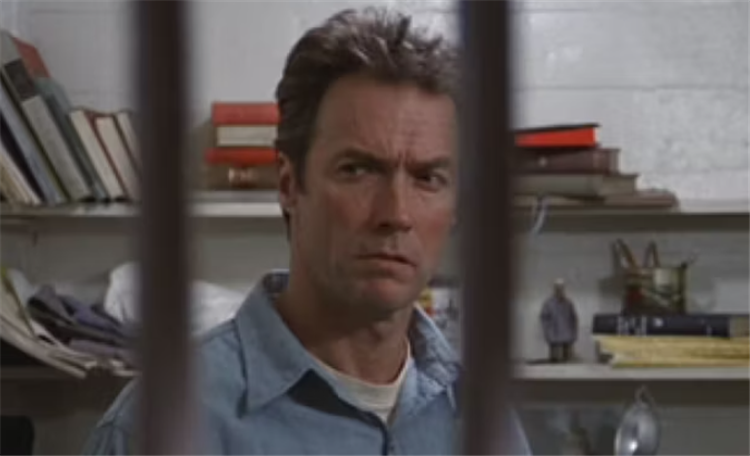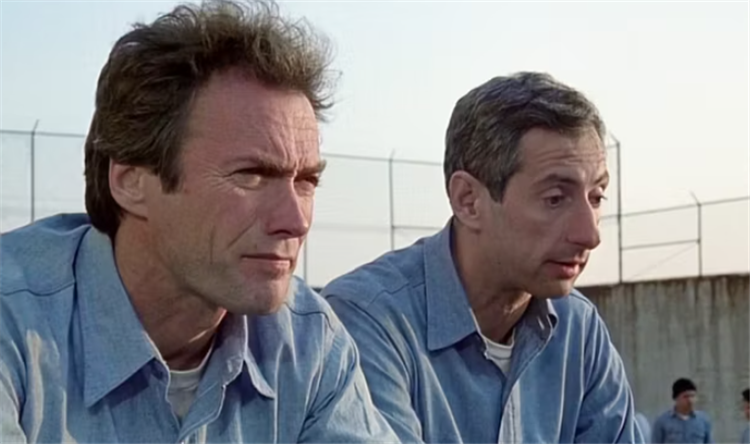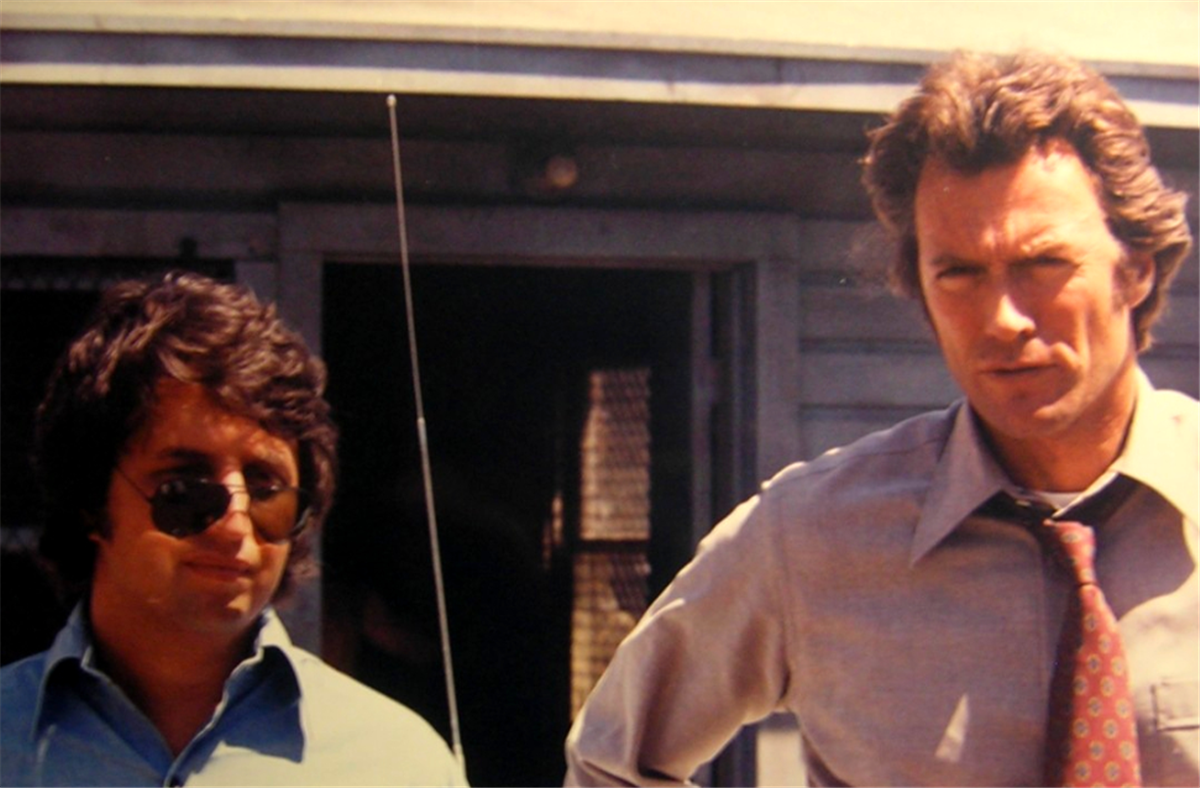With a career in film that hails back as far as 1955, it’s almost impossible for an individual not to find at least one film of Clint Eastwood’s they enjoy. Westerns? There’s one or two. Monster movies? Does Revenge of the Creature ring a (diving) bell? Suspense thriller? It’s hard to beat In the Line of Fire. Musical? Yep — Paint Your Wagon. Clint Eastwood has appeared at least once in almost every genre of film, and directed a healthy portion of them to boot. Speaking of boots, cowboy boots to be specific, the apex of his directorial efforts has to be 1992’s Unforgiven, a powerful film that deconstructs the Western genre and reinvents it going forward. It’s a critically acclaimed winner of four Academy Awards, including Best Picture and Best Director. On industry gospel review aggregator Rotten Tomatoes, Unforgiven sits at 96%. Not bad, but not as good as the 97% for a film that he did not direct: Escape From Alcatraz.
‘Escape From Alcatraz’ Is Based on a True Story
Escape From Alcatraz details the true story of the only successful prison escape from the infamous facility. The history of the haunting fortress dates back to 1861, but earned its notoriety upon being converted to a maximum-security federal prison from 1934 to 1963. Clint Eastwood plays Frank Morris, a highly intelligent prisoner who had escaped from a number of prisons before, and was placed in Alcatraz because of its ‘inescapable’ reputation. The film begins with Morris’ arrival at Alcatraz, where he meets Warden Dollison (Patrick McGoohan) before being escorted into his new digs. Morris makes friends and foes alike, befriending English (Paul Benjamin), Litmus (Frank Ronzio), and Doc (Roberts Blossom), the latter of whom paints portraits that contain chrysanthemums, which he deems are symbolic of the human spirit and freedom (pay attention, friends). Morris instantly finds himself decidedly at odds with Wolf (Bruce M. Fischer). After an altercation in the prison yard, both Morris and Wolf are sent into isolation.
After being released from solitary confinement, Morris becomes acquainted with a new inmate, Charley Butts (Larry Hankin), and settles into the daily routine. It isn’t long before the truly ugly side of Alcatraz rears its head, with the warden ordering that Doc’s painting privileges be immediately revoked, a cruel act that takes away Doc’s escape from the realities of prison life and drives him to sever three fingers off of his right hand… all because the warden didn’t like the portrait that Doc had made of him. Shortly after the incident with Doc, Morris gets reacquainted with bank-robbing brothers John (Fred Ward) and Clarence Anglin (Jack Thibeau), having met previously at another prison. While sitting in his cell, Morris makes a life-changing observation. He notices that the concrete around the grille can be chipped away, and he learns the same is true for the Anglin brothers and Butts.
How Does Frank Morris Escape From Alcatraz?

The discovery is the genesis of an escape plan, and over time, all four chip away the concrete in their cells with makeshift shovels until they make holes big enough to crawl through. The holes are covered by cardboard during the day, painted to look like concrete. However, Morris knows that simply crawling through a hole won’t end well, given how their absence would alert the prison guards. Crafty Morris suggests crafting papier-mâché dummy heads with flesh-colored paint and real hair to throw the guards off the scent. The heads work as intended, with one suspicious guard stymied by Morris’ return to his cell before the decoy is discovered. As for what to do once on the outside, John Anglin covertly smuggles raincoats from the clothing shop, then coats them with contact cement for a makeshift raft and life preservers. Having scoped out the escape route, Morris suggests they make their escape in a few days’ time, allowing for the rafts to be completed.
When the day arrives, Morris places a chrysanthemum at a table during dinner, serving a double-purpose. First, to honor the memory of Doc, and secondly, to taunt the warden. The latter wasn’t intentional, but nevertheless, the warden gets his knickers in a knot and demands an inspection of Morris’ cell, which comes up empty. He then demands that Morris be relocated to a new cell in the morning. Ready or not, the plan is a go. The four plan to meet in the passageway, only Butts backs out at the last moment. The remaining three can’t wait for Butts to grow a pair and change his mind, and carry on (he does change his mind, but too late). The escapees hit the roof, scramble down the building and over a barbed-wire fence. Once at the shoreline, they inflate the raft and head into the treacherous waters of the San Francisco Bay and to freedom. When the escape is discovered the next morning, a frantic manhunt ensues which turns up shreds of raincoat and other items belonging to the trio, but no concrete evidence that would support them having drowned or successfully made it to shore. After a dressing-down at the hands of his superiors, Warden Dollison is stripped of his duties. Defeated, Dollison finds a chrysanthemum flower head on a rock by the shore. A flower that isn’t even native to the area. The movie ends with a post-script that says the escapees are never found, and Alcatraz would be closed less than a year following the film’s events.
What ‘Escape From Alcatraz’ Has Over ‘Unforgiven’

Escape From Alcatraz is, apart from a few variances, quite accurate in its depiction of the actual 1962 event that saw the Anglin brothers and Frank Morris become the only three prisoners to escape Alcatraz, or at least what could be pieced together from what author J. Campbell Bruce found for his 1963 book of the same name. Yet the adherence to facts is only one element that elevates what could have been a run-of-the-mill prison escape film like others before, and after, it. Director Don Siegel turns Alcatraz itself into a character for the film, a foreboding presence that seeks to crush any hope of those within its walls with stifling constriction. In doing so, Siegel creates the perfect foe for his frequent collaborator, Clint Eastwood. It came at the right time for Eastwood, who, thanks to his “Man With No Name” Spaghetti Westerns and the Dirty Harry films, was an unstoppable force in his films. Eastwood was the ultimate tough guy who couldn’t be defeated, but Alcatraz became the one foe that posed a real challenge to that ideal. The film also doesn’t shy away from its depictions of life for the prisoners, from the warden’s dehumanizing actions to the violence of prison discipline. There’s rising tension, close calls, and urgency in almost every frame of the film, but each scrape the characters make at the concrete builds a slow belief that maybe, just maybe, they can pull off the escape, particularly impressive given the audience knows what happens at the end.
So why does Escape From Alcatraz earn that extra 1% over Unforgiven on Rotten Tomatoes? Hard to say. Perhaps by dividing his time between directing and acting in Unforgiven, Eastwood’s focus on the character is lessened ever so slightly, where Escape From Alcatraz has the benefit of a singularly focused Eastwood as an actor. Perhaps rumored tensions between Siegel and Eastwood during production heightened the necessary tension naturally. Unforgiven is a downer, where Escape From Alcatraz gives an ambiguous, but hopeful, ending, delivering on its themes of the power of the human spirit and the value of freedom. Whatever the case may be is moot: both films feature Eastwood at his very best, in vehicles that are worthy of it. For the record, as recently as 2022, the U.S. Marshals Service released renderings of the three fugitives on a potentially credible tip that at least one is still alive. Roll out the chrysanthemums.
